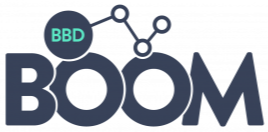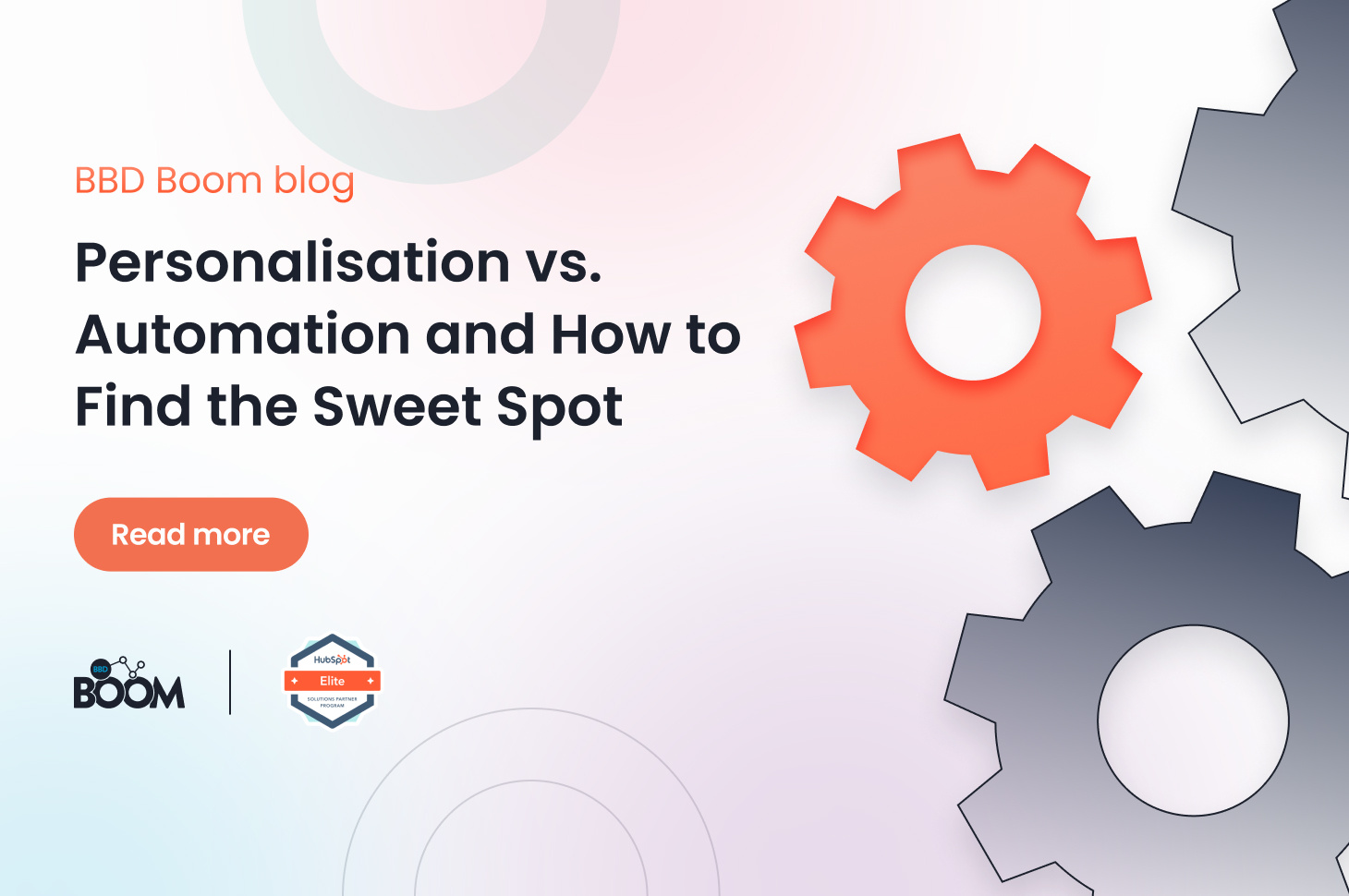The old age marketing dilemma, do you go personal or do you go efficient? One promises deeper connections, the other delivers scale and efficiency. But do you really have to choose? Lets take a look at how to find the perfect balance and why finding that sweet spot is the key to smarter, more effective campaigns.
Personalisation: The Human Touch That Converts
You know that feeling when someone remembers your name, your favourite coffee order or even just asks how your day’s going and actually means it? That’s the magic of personalisation. And in marketing, it works the same way.
Personalisation is making people feel like you're talking to them, not at them. You can use the information in your CRM like industry or job title to make your messaging more relevant and ultimately more valuable. It can be as simple as using someone’s first name in an email subject line, or as sophisticated as giving a completely tailored product recommendation based on their browsing habits. Done right, it shows your audience that you get them, and that builds trust fast.
Customers are feeling increasingly disconnected - 61% believe they're often treated like numbers rather than individuals. This is why personalisation is so important. When your marketing feels human, it fosters a sense of trust. People want to feel understood, and when they are receiving communications that feel personal to them they are more likely to react positively. For example, when your content feels relevant, people are far more likely to open, click, read and engage. Whether it’s an email, ad or a website page - when it's speaking directly to someone’s needs or interests, it grabs attention.
Personalisation doesn’t have to be complicated - it just has to be relevant. Start with the basics: names, job titles, company info or industry. Use the data you already have to make your content feel more like a conversation than a broadcast. For example, an email that says “Hi Sarah, we’ve got something just for marketing leaders in tech” is far more engaging than a generic “Dear customer” message. It’s small, but it shows you’re paying attention, and that goes a long way.

And it isn’t just limited to emails. You can adjust your website, content and even product recommendations based on someone’s behaviour or preferences. If a visitor keeps checking out your pricing page, show them a case study next time they return that's with a company in their industry. If they’ve downloaded a guide on lead generation, suggest a webinar on the same topic. You want to make each interaction feel one step ahead - like your business just gets them.

Automation - Scale Without the Strain
When your to-do list is growing faster than your lead list, automation can feel like a lifesaver. It’s what allows you to send timely, relevant messages at scale - without needing to hit “send” 500 times a week.
But let’s be real, automation does have a reputation. When done poorly, it can feel cold, impersonal, and, well… robotic. We’ve all seen those emails that start with “Hi [there]” or the ones that completely miss the context of where we are in the customer journey. That’s the danger of relying on automation without intention. When your messaging lacks relevance or empathy, people notice and they disengage.
When it’s done right, automation can transform the way you work. There’s a lot more to automation than scheduling a few emails. When used intentionally, it can be a full ecosystem that supports your marketing efforts, quietly and effectively. Here are a few simple ways to bring automation into your marketing:
Drip Campaigns
Set up a series of emails that guide someone through a journey, whether it’s onboarding, education or decision-making. It's great because you write it once, and it runs on its own, delivering value at each step without any manual follow-up.
Smart Scheduling for Content and Social
Planning ahead pays off. Tools like HubSpot let you line up content weeks (and even months) in advance. Blog posts, social updates, email newsletters - you can map it all out, hit schedule and relax knowing your audience won’t be left with no content.
Automated Follow-Ups
Following up is crucial, but it’s also easy to forget. Automation handles that for you. Whether it’s a reminder email a few days after a webinar or a gentle nudge after a quote request, you can set it up and forget about it, without seeming like you did.
Chatbots
Not every question needs a human. Automated chatbots can help answer common queries, guide users to the right resources, or even book meetings, instantly. Just make sure there’s always a clear path to a real person when needed.
Where It Can All Go Wrong?
Automation and personalisation are powerful tools - but when they’re misused or misunderstood, they can quickly unravel your entire customer experience.
Let’s start with automation. When it’s done well, it’s invisible - in the best way. But when it goes wrong, it’s glaringly obvious. Think: receiving the same email three times, being followed around the internet by irrelevant ads or getting a “Thanks for signing up!” email when you’ve been a customer for months. It’s frustrating, and it makes people question whether your brand actually knows, or cares, who they are.
Most of the time, these mistakes happen when automation is set and forgotten. Maybe the logic isn’t tight enough, maybe no one’s reviewed the workflows in months or maybe the data just isn’t accurate anymore. Whatever the cause, the result is the same: disconnected messaging that chips away at trust.
Now let’s talk personalisation - because yes, it can go wrong too. One of the biggest mistakes marketers make is over-personalising without context. Just because you can include someone’s first name or company in a message doesn’t mean you should. Especially if it feels forced or wildly off-topic. (No one wants to get an email that says, “Hi Sarah, how’s life at Picture Solutions?” when she left that company six months ago.)
In both cases, whether you’re automating or personalising, the root issue is usually the same: a lack of strategy, empathy or simply regular review. Automation needs rules and boundaries. Personalisation needs relevance and accuracy. Without those, even the most well-intentioned campaigns can end up doing more harm than good.
The Sweet Spot: Personalised Automation
If automation is about efficiency and personalisation is about connection, the sweet spot is where your marketing feels both smart and human. It’s when technology enhances the experience without overshadowing it, and your audience gets relevant, timely messages that still feel like they’re coming from a real person. So, how do you strike the right balance?
1. Map the customer journey.
Understand the key stages your buyers go through so your automation supports them with timely, relevant content—not just generic follow-ups.
2. Segment your audience.
Use key traits like industry, role, and behaviour to group contacts and tailor messaging that feels more personal and relevant.
3. Go beyond [First Name].
Real personalisation means using data to reference interests, behaviours, and needs—not just inserting a name token.
4. Blend automation with human touch.
Use automation to trigger conversations and hand over to real people when it matters, like after a demo request or high-intent activity.
And don’t forget to audit regularly. What worked last quarter might not resonate now. Keep an eye on your engagement metrics and fine-tune your messaging as your audience and goals evolve.
Ready to Find Your Balance?
Getting automation and personalisation to work together doesn’t have to be complicated - especially when you have the right tools. With HubSpot, you can tailor your messaging and create campaigns that feel both efficient and human.
At BBD Boom, we help businesses get the most out of HubSpot - whether you’re just starting out or looking to take things to the next level. Ready to find the sweet spot? Let’s make it happen.

.png)





-1.png?width=930&height=279&name=BBD-Boom-1000x300%20(1)-1.png)




